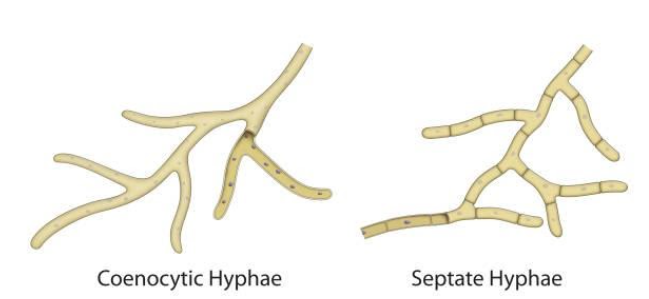
What is coenocytic mycelium?
Answer
503.7k+ views
Hint: Coenocytic refers to a structure of an organism or an organism itself, that has multiple nuclei in a continuous protoplasmic mass, enclosed by a cell membrane or cell wall. This condition is generally found in the case of algae or fungi.
Complete answer:
A majority of fungi are filamentous in their form. Meaning, they constitute long thread-like structures that are known as Hyphae. And a collection of hyphae is called Mycelium (Plural-mycelia). These mycelia can either be septate or coenocytic. Look at the diagram below:

Fig: Types of Hyphae
Concerning the diagram, the first set of hyphae has multiple nuclei (shown by the dark dots) in a continuous mass of protoplasm. This condition gives rise to the multinucleated or coenocytic condition, where several nuclei are enclosed by a cell wall in a continuous (undivided) mass of protoplasm.
In contrast, the second image shows a clear discontinuity in the protoplasm. And each divided section has one nucleus. This kind is known as Septate hyphae.
Now as we have stated earlier, that a collection or network of hyphae is known as Mycelium, so if the network is constituted by coenocytic hyphae, then such a Mycelium is known as Coenocytic Mycelium. Or simply to define it, a Coenocytic Mycelium is a network of multinucleated hyphae.
Here are some of the properties of a Coenocytic mycelium:
- Multinucleate
- Aseptate (lacks septa)
- Coordination
Additional information:
Coenocytic Mycelium is a characteristic feature of Phycomycetes.
Note: It has to be noted that the phenomenon of Coenocytic is not to be confused with Syncytium. The coenocytic condition arises when a cell fails to undertake cell division after the nuclear division. Syncytium occurs due to the fusion of multiple cells.
Complete answer:
A majority of fungi are filamentous in their form. Meaning, they constitute long thread-like structures that are known as Hyphae. And a collection of hyphae is called Mycelium (Plural-mycelia). These mycelia can either be septate or coenocytic. Look at the diagram below:

Fig: Types of Hyphae
Concerning the diagram, the first set of hyphae has multiple nuclei (shown by the dark dots) in a continuous mass of protoplasm. This condition gives rise to the multinucleated or coenocytic condition, where several nuclei are enclosed by a cell wall in a continuous (undivided) mass of protoplasm.
In contrast, the second image shows a clear discontinuity in the protoplasm. And each divided section has one nucleus. This kind is known as Septate hyphae.
Now as we have stated earlier, that a collection or network of hyphae is known as Mycelium, so if the network is constituted by coenocytic hyphae, then such a Mycelium is known as Coenocytic Mycelium. Or simply to define it, a Coenocytic Mycelium is a network of multinucleated hyphae.
Here are some of the properties of a Coenocytic mycelium:
- Multinucleate
- Aseptate (lacks septa)
- Coordination
Additional information:
Coenocytic Mycelium is a characteristic feature of Phycomycetes.
Note: It has to be noted that the phenomenon of Coenocytic is not to be confused with Syncytium. The coenocytic condition arises when a cell fails to undertake cell division after the nuclear division. Syncytium occurs due to the fusion of multiple cells.
Recently Updated Pages
Master Class 11 Economics: Engaging Questions & Answers for Success

Master Class 11 Business Studies: Engaging Questions & Answers for Success

Master Class 11 Accountancy: Engaging Questions & Answers for Success

Master Class 11 English: Engaging Questions & Answers for Success

Master Class 11 Computer Science: Engaging Questions & Answers for Success

Master Class 11 Maths: Engaging Questions & Answers for Success

Trending doubts
Which one is a true fish A Jellyfish B Starfish C Dogfish class 11 biology CBSE

State and prove Bernoullis theorem class 11 physics CBSE

In which part of the body the blood is purified oxygenation class 11 biology CBSE

1 ton equals to A 100 kg B 1000 kg C 10 kg D 10000 class 11 physics CBSE

One Metric ton is equal to kg A 10000 B 1000 C 100 class 11 physics CBSE

1 Quintal is equal to a 110 kg b 10 kg c 100kg d 1000 class 11 physics CBSE




